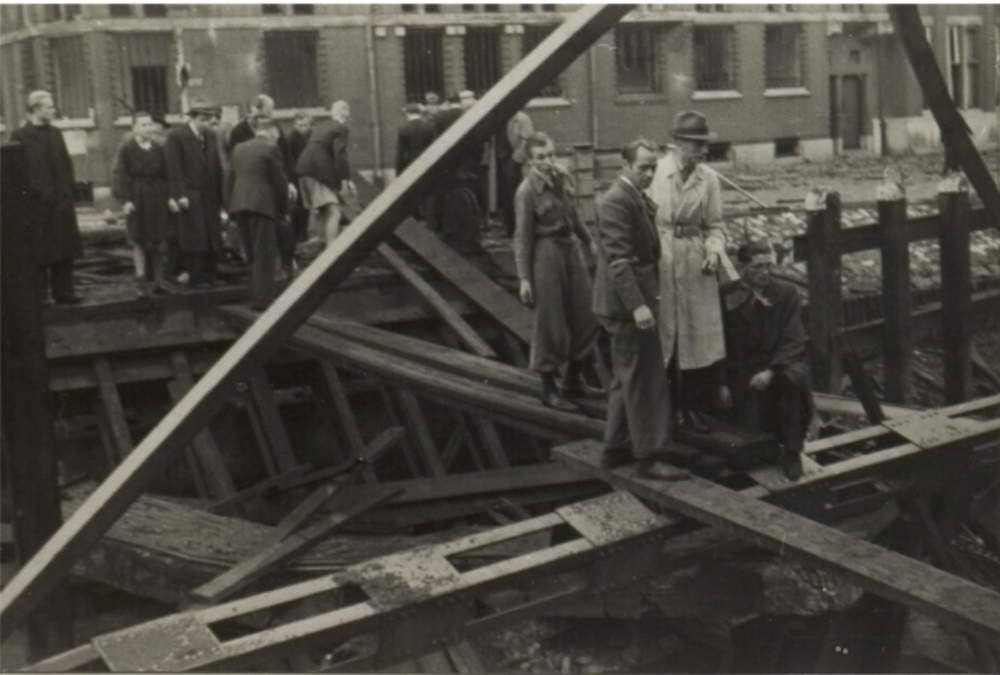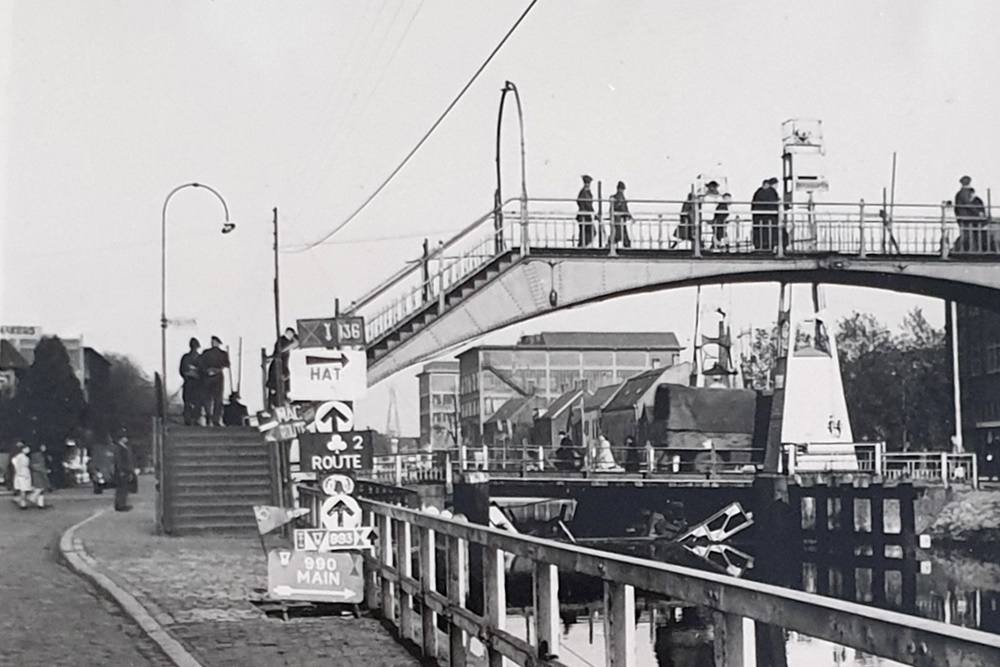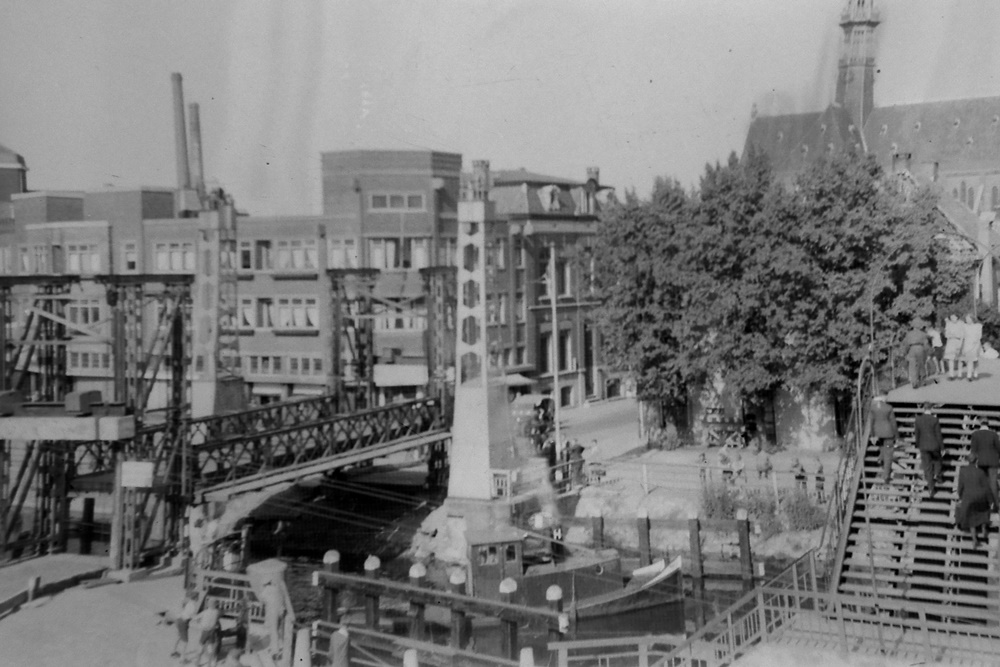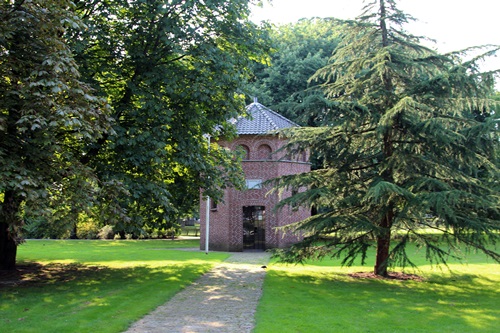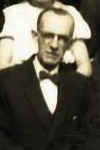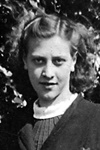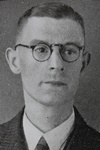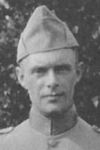Restoring the Veestraatbrug in Helmond
It has now been over three years[1] since I wrote about the discovery of a "new" wartime photo of the Veestraatbrug. Of course, the photo was not new, as it was taken in 1944, but it certainly came as a surprise for the history of Helmond. What is special about that photo is that it shows a bridge on the site of the old one. In other photos, the temporary bridge is almost always seen diagonally next to the blown-up Veestraatbrug.
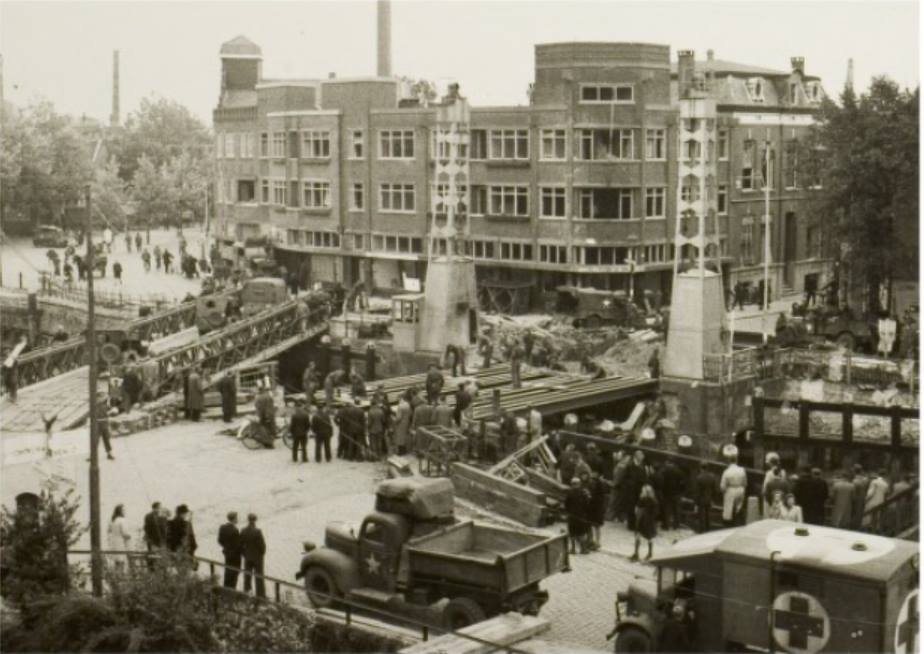
The temporary, angled Bailey bridge next to the blown up Veestraatbrug. Source: Archive Jeroen Koppes.
The Veestraatbrug in Helmond was, and is, located, across the Zuid-Willemsvaart between the Veestraat and the Steenweg. This was once a hub of thoroughfares. The Steenweg/Veestraat was the primary route through the city, on the road from Eindhoven, through Helmond to Deurne and the east. The Zuid-Willemsvaart canal there cut straight through the city. In the 1990s, it was rerouted around the city, although Helmond soon expanded further across the bypass.[2] The part going through town was used less and less, so the bridges were welded in place. Today, car traffic also runs along other routes. Thanks to major roads around and across the city, there was no longer any need to use the path via the Steenweg/Veestraat. As part of the city centre, the Veestraat became a pedestrian area.
Back to September 1944, where the Veestraatbrug was the main thoroughfare of the city. The Germans were well aware of this too, and on the eve of Operation Market Garden, a load of blasting charges was placed on the bridge. By September 22, 1944, the western part of Helmond, up to the canal, had been liberated by the British. That afternoon, moments before the British arrived, the Veestraatbrug was blown up as one of the last in Helmond.[3] On September 25, the British finally managed to liberate eastern Helmond. Meanwhile, the people of Helmond themselves were already able to construct a makeshift pedestrian crossing with a few planks from the blown-up bridge.[4]
On Liberation Day, discussions were held on how best to cross the Zuid-Willemsvaart. The Helmondsche Courant in 1947 recounted these discussions:
"The [British] colonel [...] also came to see "this case" and in his haste this eager officer already wanted to implement a very radical solution. The explosion has destroyed the abutment on the Veestraat side of the bridge, so the girders of the bridge deck were too short. Since there weren"t any longer bridging beams available, it was impossible to think of quickly constructing a permanent emergency bridge. The ingenious colonel clearly had a ready plan! He looked around and immediately found the solution. The colonel suggested - as if he was doing it daily! - "just" blowing up villa "West-End" or the Amsterdam Bank building or and shoving the debris into the canal by bulldozers. The "wide ditch" would then be filled in no time at the spot where people wanted to cross it!"[5]
Rijkswaterstaat, the Public Works Department, reacted somewhat bewildered: "If something like this has to happen, then "West End" it must be." Thankfully, in the end they were able to convince the British that damming the canal would cause major problems. Not only would it block passage of ships, but it would also block drainage, creating a risk of flooding.[6] It was reported the aforementioned colonel was from the Royal Monmouthshire Royal Engineers.[7] The Company commander was a major, which means this colonel was likely from the VIII Corps Engineers.
On the very same day, it was decided to build a Class 40 Bailey bridge.[8] With a maximum carrying capacity of 40 tonnes, this bridge was suitable for all Allied vehicles and tanks. The bridge was located next to the original Veestraatbrug, diagonally from Steenweg towards the Gedempte Haven and the Watermolenwal. This made it possible for military and civilian traffic to get across again and follow the routes through the city.
The bridge was constructed in the night of September 25-26 by the engineers of British VIII Corps. The 101st Monmouthshire Field Company, led by Major I.W. Taylor,[9] started the construction of the bridge, which had to be completed by 08:00 the next morning. They just fell short of that goal, but at 09:30 it was reported that the bridge had just been completed. The importance of this bridge to the advance was shown by the fact that it was equipped with anti-aircraft defences the same day.[10]
This crossing was not quite optimal, as people could not drive straight on from the Steenweg into the Veestraat. So it was decided to build a new Bailey bridge over the remains of the old Veestraatbrug. This Class 70 Bailey bridge was constructed with two lanes.[11] This is the bridge captured in the photo we discovered in 2021, which shows a military truck, just passing the bridge and entering the Veestraat.
Even this solution was still not perfect. A fixed bridge obstructed waterway traffic. At that time, there had not yet been dug a diversion from the Zuid-Willemsvaart; all ships also had to pass through the city. With fixed bridges, that was not an option. The aforementioned newspaper further wrote:
"The British had not foreseen the construction of moveable bridges in their army plan; they wanted fixed bridges 5 metres above the water everywhere. Colonel Shelbourne was persuaded that this was not possible in Helmond and approved the construction of a drawbridge here."[12]
Colonel Clifford Percy Shelbourne was the commander of the 2nd Port Construction and Repair Group.[13] He had already received a George Medal at the beginning of the war for his work in bomb disposal.[14] His duties included repairing the ports of Caen, Dieppe and Calais, and he was appointed an Officer in the Order of the British Empire (OBE) at the end of the war.[15]
On December 7, 1944, Shelbourne was ordered to hand over the work in Calais to the 5th Port Construction and Repair Group and prepare to start making the canals around Nederweert navigable. To this end, a reconnaissance unit was dispatched, which left on December 10 and explored the Zuid-Willemsvaart. The Meuse River, the Wilhelmina Canal and the Eindhoven Canal were also explored. On December 14, two soldiers from the reconnaissance unit went missing. They appeared to have been arrested on the Meuse River by a Canadian unit, which released them after questioning. On December 22, the unit concluded its reconnaissance and returned to France.[16]
In early January 1945, the 2nd Port Construction and Repair Group received its final assignment: "Make the Zuid-Willemsvaart navigable between the Belgian border (below Budel-Dorplein) and the Meuse near Den Bosch". The 937th Port Construction and Repair Company was entrusted with the section from Lock 8 to Den Bosch, which meant it was responsible for all the bridges in Helmond.[17]
As a result, this Company also became responsible for the Veestraatbrug in Helmond. However, this bridge was still heavily used by Allied supply troops. With Operation Veritable approaching, it was decided that this bridge should not be replaced until more than a week after the start of the operation.[18] This started on February 8, but it would take until March 5 before any work on the bridge could begin.[19]
After that, things moved quickly. On March 9, reports showed that the temporary bridge had been removed, the remains of the blown-up original bridge had been removed from the canal and the foundations on both banks were in place. One week later, it was reported that the bridge deck was ready and the towers were in place. On the 12th, the bridge had already opened to traffic, only the winches and counterweights needed to be installed at that time. On March 31, the bridge was reported to be completely finished and the canal between Lock 8 (south of Helmond) and Den Bosch had been made navigable.[20]
Until now, no photograph of the lift bridge had ever been brought to our attention. Until I received an email from Graeme Dell. His father, Sapper George William Dell, served in North Africa and Europe, and had taken a number of photographs. A few had been taken in Europe, but it took Graeme a while to identify the Helmond castle in one of the photos. He then found my article on the other photo of the Veestraatbrug and managed to identify his photo based on the buildings.[21] In Europe, his father served with the 14 Electrical and Mechanical Company of the Royal Engineers.[22]
This photo is special because it shows the lift bridge made of Bailey elements. As a ship sails under it, it is even clearer that it really is a lift bridge. An interesting element in the photo is the fixed footbridge on the right, which at the time crossed the canal. A footpath was made along the lift bridge on both sides. A number of planks on the protruding girders, fitted with a railing of raised iron bars, were connected with a simple rope.
Soon, Helmond officials complained about this rope. Not only was the railing unsafe, but there were also gaps between the planks of the pedestrian section. At busy times, this could be dangerous. On April 12, 1945, Helmond’s British Town Major was asked if this could be rectified. A few days later, on April 20, it had already been improved and the pedestrian section had a unified deck and a wooden railing.[23] It seems this was already in place in the picture above.
It is difficult to determine when exactly the photograph was taken. Graeme supposes sometime in July or August 1945, when his father was on leave.[24] Helmond was a military rest centre, so the chances of him being in Helmond at the time are quite likely. At least the bridge was in use then. Among the photos were also two from the S.H.A.E.F. expo in Antwerp. This exhibition of various war equipment opened on June 1, 1945 and closed again at the end of July.[25]
By the end of July 1945, Helmond city officials were already calling for the lift bridge to be replaced. The bridge’s towers obstructed the view in the bends too much. A drawbridge, as had always been there, was therefore more fitting.[26] This was hardly surprising, as already during construction on the night of March 17-18, a tank transporter drove into one of the towers. This happened again on March 31, this time even in broad daylight.[27] The replacement of the lift bridge was commissioned in July 1946. The N.V. Koninklijke Nederlandsche Machinefabriek, formerly E.H. Begemann of Helmond, built the bridge after which it was officially opened on July 19, 1947.[28] This bridge is still there today.
So, even 80 years after the liberation, it is still possible to come across new evidence about the war in Helmond. What a wonderful thing to see!
Notes
- TracesOfWar.com, "New" photo of the Veestraatbrug in Helmond, consulted op 03-08-2024.
- BHIC.nl, Zuid-Willemsvaart, consulted op 03-08-2024.
- RHC-Eindhoven, 12242 Luchtbescherming Helmond, doos 1.
Dagboek Alphons Niessen, 22-09-1944. - Helmondsche Courant, 18-07-1947.
- Helmondsche Courant, 18-07-1947.
- Helmondsche Courant, 18-07-1947.
- Helmondsche Courant, 18-07-1947.
- The National Archives, WO 171/287, VIII Corps G, Aug-Sept 1944.
Watson, G., Militiamen And Sappers: A History Of The Royal Monmouthshire Royal Engineers, pagina 152. - Helmondsche Courant, 18-07-1947.
The Militia Journal, The Royal Monmouthshire Royal Engineers (Militia), 02-12-2021. - The National Archives, WO 171/287, VIII Corps G, Aug-Sept 1944.
- The National Archives, WO 171/5875, 2nd Port Construction and Repair Group, 1945.
- Helmondsche Courant, 18-07-1947.
- The National Archives, WO 373/83/603, Citation, Clifford Percy Shelbourne, 1945.
The National Archives, WO 171/1419, 2 Port Construction and Repair Group, 1944.
RHC-Eindhoven, 11004 Gemeentebestuur Helmond, 1942-1967,1044 Bruggen. Herstel van oorlogsschade. - The Royal Engineers Association, George Medal, consulted op 03-08-2024
The National Archives, WO 373/83/603, Citation, Clifford Percy Shelbourne, 1945. - The National Archives, WO 373/83/603, Citation, Clifford Percy Shelbourne, 1945.
- The National Archives, WO 171/1419, 2 Port Construction and Repair Group, 1944.
- The National Archives, WO 171/5875, 2nd Port Construction and Repair Group, 1945.
- The National Archives, WO 171/5875, 2nd Port Construction and Repair Group, 1945.
- The National Archives, WO 171/5687, 937th Port Construction and Repair Company, 1945.
- The National Archives, WO 171/5687, 937th Port Construction and Repair Company, 1945.
- Mail Graeme Dell, 09-07-2024.
- Mail Graeme Dell, 02-08-2024.
- RHC-Eindhoven, 11004 Gemeentebestuur Helmond, 1942-1967,1044 Bruggen. Herstel van oorlogsschade.
- Mail Graeme Dell, 02-08-2024.
- BunkerMuseumAntwerpen.be, S.H.A.E.F. expo, consulted op 03-08-2024.
- RHC-Eindhoven, 11004 Gemeentebestuur Helmond, 1942-1967,1044 Bruggen. Herstel van oorlogsschade.
- The National Archives, WO 171/5687, 937th Port Construction and Repair Company, 1945. The National Archives, WO 171/5875, 2nd Port Construction and Repair Group, 1945.
- RHC-Eindhoven, 11004 Gemeentebestuur Helmond, 1942-1967,1044 Bruggen. Herstel van oorlogsschade.
Helmondsche Courant, 18-07-1947.
Information
- Article by:
- Jeroen Koppes
- Translated by:
- Sophie Louwers
- Published on:
- 17-09-2024
- Feedback?
- Send it!
Related themes
Related sights
Related persons
Sources
- BHIC.nl, Zuid-Willemsvaart, consulted op 03-08-2024.
- BunkerMuseumAntwerpen.be, S.H.A.E.F. expo, consulted op 03-08-2024.
- Diary Alphons Niessen.
- Helmondsche Courant, 18-07-1947.
- Mail Graeme Dell, 09-07-2024.
- Mail Graeme Dell, 02-08-2024.
- RHC-Eindhoven, 12242 Luchtbescherming Helmond, doos 1.
- RHC-Eindhoven, 11004 Gemeentebestuur Helmond, 1942-1967,1044 Bruggen. Herstel van oorlogsschade.
- The Militia Journal, The Royal Monmouthshire Royal Engineers (Militia), 02-12-2021.
- The National Archives, WO 171/287, VIII Corps G, Aug-Sept 1944.
- The National Archives, WO 171/1419, 2 Port Construction and Repair Group, 1944.
- The National Archives, WO 171/5687, 937th Port Construction and Repair Company, 1945.
- The National Archives, WO 171/5875, 2nd Port Construction and Repair Group, 1945.
- The National Archives, WO 373/83/603, Citation, Clifford Percy Shelbourne, 1945.
- The Royal Engineers Association, George Medal, consulted op 03-08-2024.
- TracesOfWar.com, "New" photo of the Veestraatbrug in Helmond, consulted op 03-08-2024.
With thanks to
- Marian Bom.
- Graeme Dell.
- Tim Gainsford.
- Lisa de Haas.
- Jackie Morris.
- Sophie Louwers.
- Ray Morris.
- Herma de Vries.
- Rod Williams.
